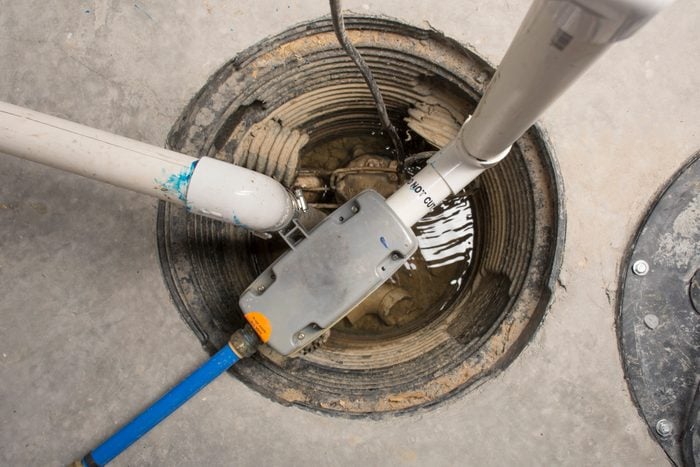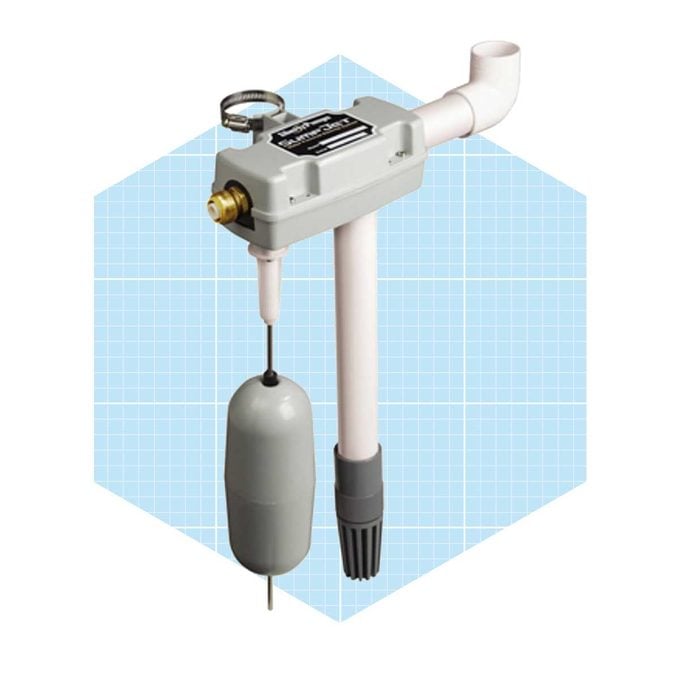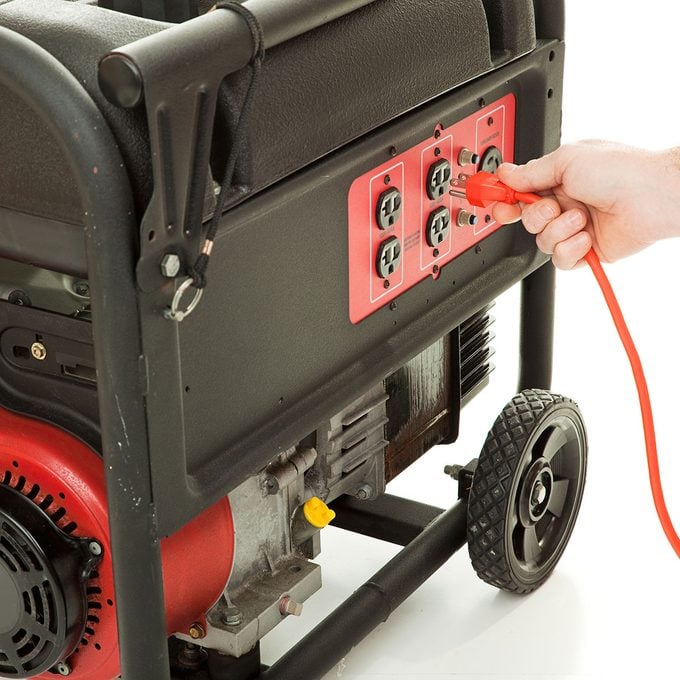Homeowner’s Guide to Sump Pump Battery Backups
Updated: Feb. 14, 2024

A sump pump installation should include a backup system for breakdowns and power outages. Learn the pros and cons of the best sump pump backup methods.
A sump pump is one of the most important (and ignored) disaster prevention devices in a home. When this simple system fails, the results can be catastrophic, leading to thousands of dollars in damage, lengthy repairs and higher insurance premiums. So spending some time and money to avoid failure makes a lot of sense.
Some homeowners keep a replacement pump on hand in case their main pump dies. That’s a good idea; home centers often sell out of pumps during storms or floods. But a replacement won’t help you if you’re on vacation during a power outage, or if your pump dies while you’re slumbering through a stormy night.
That’s the beauty of sump pump backup systems. No matter what the reason for the pump failure, a backup system saves the day. In this article, we’ll show you the options.
On This Page
What Causes Primary Sump Pumps to Fail?
The most common reason is a power outage, not some problem with the pump itself. Other common events can also cut off the supply of electricity. Lightning can trip GFCI outlets, or someone can unplug the pump and forget to plug it back in.
Assuming the power stays on, sometimes the pump itself fails. Many inexpensive sump pumps are simply too small to handle the flow from a major downpour or rapid snowmelt.
And because inexpensive pumps are built with less durable materials, they lose efficiency. So the pump runs more often and burns out early. Or the motor runs but the pump doesn’t eject water.
Float switches are also a frequent cause of pump failure. “Wide angle” tethered switches, the kind that free-float around the sump basket, are the biggest troublemakers. That freedom makes them far more likely to be trapped against the pump, discharge pipe or power cord. Once trapped, they can’t switch on the pump.
Inexpensive switches can also wear out or cause motor burnout.
How Does a Sump Pump Battery Backup Work?
A sump pump battery backup system is completely separate from your primary pump, though it’s typically installed in the same sump basket.
Backup systems work like primary sump pumps, only the float is set slightly higher than the one on the primary pump. That’s so it only kicks in if the main pump fails or there’s no power.
When the power is on and the primary sump pump functions normally, a maintainer on the backup system keeps the batteries charged to ensure they’re ready at any time.
Sizing a Pump
Whether you’re buying a sump pump or a backup system, you’ll have to determine the pump capacity. Here’s how:
Disconnect your existing pump, pull it out of the basket and check the gallons per hour (GPH) rating on the label. If you can’t find it, check the pump’s specifications on the manufacturer’s website. Buy a new pump with at least that much capacity. If your existing pump sometimes can’t keep up with the incoming water, select a model with a higher GPH rating.
Battery Backup Sump Pump Systems
A sump pump battery backup system consists of a battery, pump, charger and additional piping.
Manufacturers usually sell three models: good, better and best, with “best” costing three times as much as “good.” The “best” units come with a larger battery and a more sophisticated charger. The larger battery gives you a longer run time, and the better charger prolongs the life of the battery.
So how long will a battery backup system keep your basement dry? That depends on how much water enters your sump basket, which determines how often the pump will run.
Here’s an example: One manufacturer’s system comes with a 40-amp/hour battery that’s projected to last up to 53 hours, pumping once every five minutes at the rate of 2,300 GPH.
But if your water problems are serious enough that the pump runs once every minute, that same battery will last only 12 hours. That’s hardly enough capacity to get you through an extended power outage. In that case, buy a system with a larger battery, or a system with a charger large enough to keep two batteries fully charged.
If you have minor seepage and rarely experience power outages, you’re probably safe buying a less expensive backup system. Then again, that savings could cost you big time if one 100-year storm knocks out your power and turns a sump trickle into a flood.
Pros
- Simple installation — connect to existing discharge pipe or run a separate pipe;
- Unlike water-powered systems, battery backup systems work when there’s no water supply.
Cons
- Battery may run down before power comes back on;
- Battery water levels must be checked every few months;
- Battery terminals must be cleaned twice a year;
- Battery must be replaced every five years.
Water-Powered Backup Pumps

A water-powered backup pump uses water pressure to siphon water out of your sump. Most use one gallon of city water for every two gallons of sump water they remove. So a pump that’s capable of removing 1,500 GPH will use 750 GPH of city water. And that’s created a lot of controversy.
A few municipalities prohibit these kinds of pumps due to already severe water shortages, so check with local authorities before buying one. In an area with high water costs, the water bill can run as high as $170 a day. But keep that in perspective. If your power goes out for a couple of days, you’ll happily pay a $300 water bill to avoid a flood.
Water-powered pumps require at least 40 pounds pr square inch (psi) and a 3/4-inch feed line to achieve maximum pumping rates. And they require a separate drain line and some type of backflow prevention to prevent cross-contamination with potable water.
Water-powered pumps come in two styles: in-sump and above-sump.
An in-sump pump is always immersed in drain water, increasing the risk of drain water contaminating the drinking water supply. To prevent that, most local codes require the installation of an expensive reduced pressure zone (RPZ) backflow prevention valve.
RPZ valves must be professionally installed and tested annually by a licensed plumber. That adds an annual cost to the system. So check with your local building inspection department before you buy.
An above-sump unit mounts well above the sump, reducing the risk of contamination. Therefore, many plumbing inspectors require only a less expensive atmospheric vacuum breaker (AVB).
Pros
- No limit to run-time — works as long as you have water pressure;
- No battery replacement costs;
- No routine maintenance.
Cons
- If you have a well, this setup won’t work during a power outage;
- More difficult installation because it requires a new water line, backflow preventer and new drain line;
- Annual fee for RPZ valve testing (if required by local code);
- May be expensive to run in areas with high water costs.
Power Your Sump Pump with a Generator

During a power outage, a backup generator can pay for itself by powering a sump pump. A typical sump pump draws about nine amps, so it won’t add much load to the generator.
But a generator isn’t a perfect substitute for a backup system. A battery- or water-powered system kicks in automatically, whether you’re home or not and no matter what the failure. A portable generator works only if you’re around to connect it. And a generator (standby or portable) won’t help if your primary sump pump is kaput.
Pros
- No need to add other pumps to your sump pump system;
- Can power a sump pump during a long outage (providing there’s fuel);
- Depending on size, can power other appliances.
Cons
- Someone must be present to turn on the generator and plug in the pump;
- Generators are expensive and can be costly to run;
- Generators require their own maintenance and storage;
- Won’t help if your primary sump pump fails.
Know When Your Pump is Dead
Too often, homeowners don’t discover a sump pump failure until they see the damage. But there are ways to avoid that.
If you buy a new AC sump pump run by a controller, it will come with some type of alarm to let you know if the pump fails or the power goes out. The same holds true for most new battery-powered systems. In the event your sump pump system doesn’t include an alarm, there are a few aftermarket models available.
- Local alarm: Detects water at the top of the sump basket using a probe or a float and sounds an audible alarm. Local alarms are great if someone is home at the time of the failure.
- Verbal message via landline: Detects water at the sump, dials a preprogrammed phone number and plays a recorded message. Also sounds an audible alarm. Must have a landline.
- Text messaging: Detects water at the sump and sends a text to three cell phones. Search “high water text notification” for companies that provide this service.
How to Choose a Replacement Sump Pump
Home centers sell a confusing array of sump pumps, costing $50 and up. But don’t despair. We’ve reviewed all the specs, talked to the engineers and boiled it down to five simple buying tips:
- Check pumping volume: Horsepower means nothing; it’s the pumping volume in GPH that counts. Check the capacity of your current pump. If it keeps up with the flow during the heaviest rainstorms, buy that capacity again. If not, buy a pump with a higher GPH rating. To find your current pump’s rating, locate its make and model number on the label and find the specs on the manufacturer’s website.
- Check the “head” on the manufacturer’s GPH rating: Head is the height that water must be lifted from the pump to the horizontal discharge pipe. More height means harder work for the pump. The GPH rating on most good-quality pumps includes the head (typically 10 feet). But some manufacturers rate pump capacity without head (i.e. “3200 GPH at 0 head”). That gives an unrealistic — and misleading — estimate of pump capacity.
- Spend the money on a quality sump pump: Look for a caged or vertical float switch, a motor with a UL and a CSA rating, and a stainless steel, cast aluminum or cast iron impeller and pump body. Avoid pumps made from epoxy-coated parts.
- Buy an energy-efficient pump: Once you find a pump with the correct GPH rating, look for a model that consumes the fewest amps. This isn’t about saving electricity; high-amp pumps run hotter and burn out the float switch faster.
- Buy a “top suction” pump that’s “solid passing”: If your sump accumulates gravel or sand, this will prevent a stall/burnout from trapped gravel. Or raise a “bottom suction”-style pump on a few bricks to keep it off the bottom of the sump.
- Buy fresh hardware: While you’re at the home center, pick up a new male fitting for the pump outlet; pipe primer and cement; a new check valve and rubber couplers. This will save you a trip to the store in the middle of installing the sump pump.